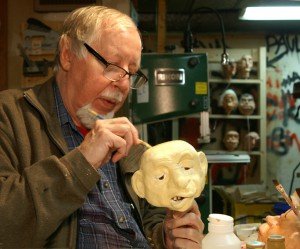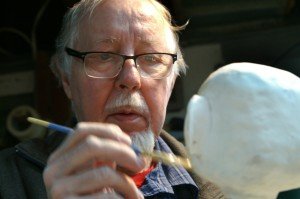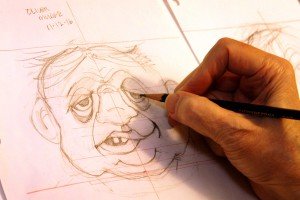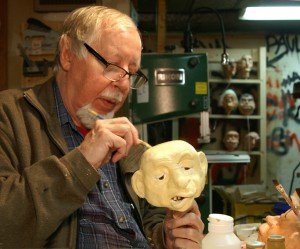By JAN WILLMS
Photos by TERRY FAUST
 For his third career, Longfellow resident Paul Eide (photo right) has turned to puppet making. Specifically, he is creating the heads of puppets.
For his third career, Longfellow resident Paul Eide (photo right) has turned to puppet making. Specifically, he is creating the heads of puppets.
Creativity has been a part of his work ever since he graduated from the University of Minnesota with a degree in education. He was involved with puppetry even back then, and he was hired to make two puppets for a public service announcement.
“This was a time when there was a lot of worry about nuclear war,” Eide recalled. “These public service announcements were designed to teach farmers how to protect their cows from nuclear fallout by stacking bales of straw around them. This was to protect the cows from Strontium 90. I doubt too many farmers were up watching TV at 1am when these PSAs ran.”
When that project was finished, a job became available in the film department. “I intended to stay there for a couple of years, and I stayed there for the next 35,” Eide said.
“We did 15-millimeter films, educational movies on all sorts of topics: the arts, medicine, and anthropology. It was a wonderful job. I realized looking back how lucky I was to have that job,” Eide added. He retired from that job in 2000. “That was the end of my first career,” he noted.
While still working at the U, he combined his interest in puppetry and writing and became editor of the Puppetry Journal, a quarterly magazine produced for Puppeteers of America, a national organization. “I did that for the next 15 years,” Eide said. “It was a one-man production thing. I did some of the writing, all of the layout and graphic design, for better or worse.” He said that over a year ago, he decided to turn it over to somebody a couple of generations younger. “By then, I was 76,” Eide reflected. “I enjoyed this too, but I didn’t want to keep somebody else from doing it, so I stepped aside.”
Eide was at loose ends last year. Even though editing the Puppetry Journal had been a part-time job, he said it consumed him all the time. “I was constantly tracking down people to write articles and planning the next two issues,” he said. So when he retired from it, he was used to putting in a lot of working hours.
 Photo left: “It is one of those things that you can think about when you wake up in the middle of the night," said puppet-maker Paul Eide. "It has been very much fun, and a good use of my time.” (Photo by Terry Faust)
Photo left: “It is one of those things that you can think about when you wake up in the middle of the night," said puppet-maker Paul Eide. "It has been very much fun, and a good use of my time.” (Photo by Terry Faust)
“Around that time, last winter, a very, very talented puppeteer in Toronto, Ronny Burkett, was making puppets,” Eide said. “Burkett is one of those talented people that makes you shake your fist at the heavens and say ‘Why did you give him all the talent?’”
Burkett looked like a movie star, had a great voice, built these puppets, and wrote award-winning plays that would sell out. “He would perform all by himself to great acclaim,” Eide added. “He’s a Facebook friend, and he started posting pictures of puppets he was making for shows.”
Eide said Burkett was undertaking making 100 hand puppets to hand out to his audience to use and return them. He would post pictures of a lot of the puppets as he was making them. And as a Facebook friend, Eide viewed these different puppets.
“I thought ‘What would that be like?’ It made me think of my old high school art teacher when she was instructing us in watercolors. She told us the first 100 are the hardest, which implied that by the time you made 100, you would know what you were doing. Or not.”
 Photo left: Paul Eide first sketches the puppet in front and side views to understand its individual "personality." (Photo by Terry Faust)
Photo left: Paul Eide first sketches the puppet in front and side views to understand its individual "personality." (Photo by Terry Faust)
“At that time I was looking at a project for post-retirement. What if I set out to make 100 puppets?” And so Eide began working on his third career.
He said that the head is the most important part of a puppet because that is where the personality lies. So that is the part he concentrated on.
“I had made puppets off and on, all my life, and they were good enough. But I would like to make puppets that were really good. So I started experimenting with methods and materials of all sorts.”
Eide said the kind of puppets he likes to make are rod puppets. “Hand puppets are controlled by the hands, and marionette puppets are controlled by strings. In between, there are rod puppets, which have a rod for the head and rods on hands. They don’t have legs, generally, but you can get quite a bit of expression out of rod puppets with sweeping gestures.”
 Photo right: Buster the cat watches over the work in Paul Eide's workshop. Eide gives every puppet a name to fit its personality. He created one that looks like his grandmother’s sister. One developed from a Sherlock Holmes story he was listening to on the Internet. (Photo by Terry Faust)
Photo right: Buster the cat watches over the work in Paul Eide's workshop. Eide gives every puppet a name to fit its personality. He created one that looks like his grandmother’s sister. One developed from a Sherlock Holmes story he was listening to on the Internet. (Photo by Terry Faust)
“Every puppet had to have a mouth that opened and closed,” Eide explained. “I tried various construction methods and materials to cover them with and finish them with. I am now on puppet number 12, so I am just embarking on this.”
He claimed the puppets he has made so far all have a defect or some inadequacy. “By the time I get to 30 or 40, I might be reasonably good at it,” he chuckled.’
Eide said a puppet is like a musical instrument and a puppeteer like a musician. “A puppet comes to life when you move it,” he noted. “The instrument a musician picks up has to not only sound good but has to be built, so there are no impediments.” He aspires to make a puppet that works as well in the hands of a puppeteer; that is so reliable and smooth it feels good to hold it and make it come to life.
“I am experimenting with different finishes with the puppets,” Eide said. “There are little things, like a mouth that doesn’t close as it should, that I have to master.” He gives every puppet a name to fit its personality. He created one that looks like his grandmother’s sister. One developed from a Sherlock Holmes story he was listening to on the Internet. “There was a character who was a slightly deaf bell-ringer, and I imagined what he might look like,” Eide said. He draws front and side views of every puppet, making sketches of them at different stages.
 Photo left: Longfellow resident Paul Eide was looking for his "third career" when he was inspired by the work of Toronto puppet-maker Ronny Burkett. Eide has set a first goal of making 100 puppets. (Photo by Terry Faust)
Photo left: Longfellow resident Paul Eide was looking for his "third career" when he was inspired by the work of Toronto puppet-maker Ronny Burkett. Eide has set a first goal of making 100 puppets. (Photo by Terry Faust)
He works on more than one at a time. He said the structure is wood. He uses installation foam that comes in 4x8 foot sheets, cutting up and shaping with electric wire. Paper clay is used to complete the head, which can be sanded smooth and painted.
He has a workshop in his basement where he creates the puppets. “I try to go there while the cat is still sleeping,” he joked. His cat, Buster, likes to supervise while Eide works.
“I am enjoying this a lot. It is one of those things that you can think about when you wake up in the middle of the night. It has been very much fun, and a good use of my time.”
Eide reflected that puppetry is growing and changing. “The kind of puppets people are using change over the decades,” he said. “You could have made a living building marionette shows and touring schools. Now the school funding has dried up. But puppetry is going as strong today as ever. The main difference between now and fifty years ago is that contemporary artists don’t feel constrained by traditional forms and formats and puppetry styles. They experiment with any and all methods of giving objects the illusion of life, intelligence, personality, emotion–-which is what puppetry is.”
“Today a puppet can be anything, and it can be made to move by strings or rods or multiple puppeteers standing behind it in full view, making it move,” Eide continued. “There are many young puppeteers who are doing very good and very adventurous work–-just look at our two permanent puppet theaters in the Twin Cities: Heart of the Beast and Open Eye Figure Theater.”
And puppetry is a long-lasting career. Eide said that puppeteers from the age of four who knew what they wanted to be are still practicing the art of puppetry in their 80s.
Comments
No comments on this item Please log in to comment by clicking here